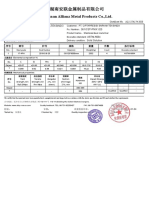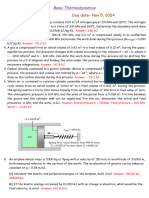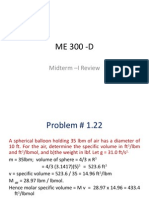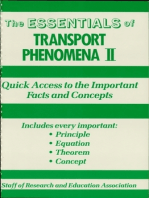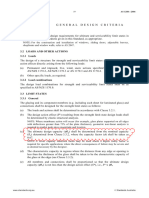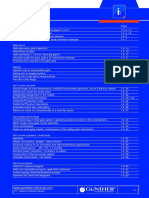Thermal and Fluids Engineering I
Thermal and Fluids Engineering I
Uploaded by
mahmoud2mirzaCopyright:
Available Formats
Thermal and Fluids Engineering I
Thermal and Fluids Engineering I
Uploaded by
mahmoud2mirzaOriginal Description:
Original Title
Copyright
Available Formats
Share this document
Did you find this document useful?
Is this content inappropriate?
Copyright:
Available Formats
Thermal and Fluids Engineering I
Thermal and Fluids Engineering I
Uploaded by
mahmoud2mirzaCopyright:
Available Formats
Thermal and Fluids Engineering I
Exam #1 Fall 2011
1)
You will have 1.5 hour = 90 minutes = 5400 seconds to complete this exam. Please budget your time to allow for completion of all the problems. Remember every item has dimensions and units associated with it. Using those units during your calculations will help prevent errors. Grading Problem 1 Problem 2 Problem 3 30 pts. 40 pts. 30 pts.
2) 3)
Name:
1. An ideal gas of molecular weight 35 is contained in a 1 m3 pressure vessel. The gas is initially at 1 MPa and 150 C. The gas receives 7.2 MJ of work while 1.5 kW of heat is removed from the system. a) Calculate the internal energy change for the system over the period of one hour. First Law for closed, constant volume system. System is gas in the container.
!U = Q " W Q = "1.5 kW * 3600 W = "7.2 # 10 6 J
1 s = "5400000 J hr
heat removed from system
work done on the system
2 3
!U = "5.4 # 10 6 " ( "7.2 # 10 6 ) = 1.8 # 10 6 J
b) Calculate the amount of gas inside the vessel. Use the ideal gas law.
PV = nRT 1 ! 10 6 Pa (1m 3 ) PV n= = = 0.284 kgmol J RT 8314 (423K ) kgmolK
c) Calculate the final state of the gas (T, P) assuming the molar specific heat of the gas, Cv, is 12.5 kJ/kgmolK. For an ideal gas, the internal energy is only a function of temperature.
!U = nC v ( Tend " T start ) !U = 1.8 # 10 6 J = ( 0.284 kgmol ) (12500 ) ( Tend " 150 ) Tend = 657C
2 3 1
d) Calculate the enthalpy change for the gas. The enthalpy change for the gas is determined from the temperature rise and Cp.
Cp =
1 dH 1 d 1 d = (U + PV ) = (U + nRT ) = C v + R n dT n dT n dT J J J + 8314 = 20814 kgmolK kgmolK kgmolK
C p = 12500
" % J !H = nC p !T = 0.284 kgmol $ 20814 ( 657 ( 150 ) = 2.997 ) 10 6 J ' # kgmolK & 3
2.
A 1-kg quantity of hydrogen undergoes the following sequence of quasistatic processes in a piston/cylinder arrangement: a) b) c) An adiabatic expansion in which the volume of the gas doubles A constant volume process in which the pressure is restored to its initial value A constant pressure process where the system is brought back to its initial temperature.
The hydrogen is initially at 120 C and 5 atm pressure. Determine the internal energy change of the gas, the heat exchanged and the work done during each stage. cv = 10.3 kJ/kgK a) cp = 14.5 kJ/kgK
Adiabatic expansion means polytropic process and Q = 0. 2
!U = "W = "
P2V2 " P1V1 1" k T1 = 393K m = 1kg
P1 = 5.066 # 10 5 Pa
$ ' J ( 393K ) % ( kgmolK ) mRT1 V1 = = = 3.225 m 3 $ M w P1 kg ' 2 ( 5.066 # 105 Pa ) & % kgmol ) (
(1kg ) & 8314
V2 = 2V1 = 6.45 m 3 k= cp ~ 1.398 cv
k 1.398
$V ' $ 3.225 m 3 ' P2 = P1 & 1 ) = ( 5.066 # 10 5 Pa ) & % 6.45 m 3 ) ( %V (
2 5 3
= 1.922 # 10 5 Pa
(1.922 # 10 Pa )( 6.45 m ) " ( 5.066 # 10 Pa )( 3.225 m ) = 9.902 # 10 W = "!U =
5 3
1 " 1.398
J3
b)
In a constant V process, W = 0.
!U = Q From part a !U = "9.902 # 10 5 J = mcv !T = 1(10300 ) (T2 " T1 ) T2 = 23.9C 2 1
Using the ideal gas law we can get the final state of the gas.
P1V1 mRT1 = P2V2 mRT2
V1 = V2
P1 1.922 ! 10 5 T 23.9 + 273 = = 1 = 5 P2 5.066 ! 10 T2 T2 T2 = 782.5 K = 509.6C Q = mc v "T = 1 (10300 ) ( 509.6 # 23.9 ) = 5.003 ! 10 6 J
c) For this process, we cool off and compress the gas.
1 2
!U = mc v !T = Q " W 1 (10300 ) (120 " 509.6 ) = "4.013 # 10 6 J = Q " W W = P !V = 5.066 # 10 5 ( 3.225 " 6.45 ) = "1.634 # 10 6 J Q = !U + W = "1.634 # 10 6 " 4.013 # 10 6 = "5.647 # 10 6 J
We can also do this part starting with the enthalpy and !H=Q.
2 1 3 3
3. A composite wall constructed of 2.5 cm steel (ks = 60.5 W/mK) and 5.0 cm of aluminum (ka = 177 W/mK) separates two liquids. The liquid on the steel side has a heat transfer coefficient of 15 W/m2K and a temperature of 400 C. The liquid on the aluminum side has a heat transfer coefficient of 30 W/m2K and a temperature of 100 C. a) Calculate the amount of heat transferred per unit area between the two fluids. b) Assuming that steady-state conditions have been reached, what is the approximate temperature at the steel-aluminum interface? c) Assuming that steady-state conditions have been reached, what is the temperature at the steel/liquid interface?
T1 ) T* 400 ) 100 W ! W $ 'T q "# 2 & = overall = = = 2979 2 "m % m ( R Ls + La + 1 + 1 0.025 + 0.05 + 1 + 1 ks ka hs ha 60.5 177 15 30 5 q " = 2979 = T*s ) T2 400 ) T2 = 1 Ls 1 0.025 + + hs ks 15 60.5 5
T2 = 200.2C q " = 2979 = T*s ) T3 400 ) T3 = 1 1 hs 15
T3 = 201.4C
You might also like
- Mill Mill Mill Mill Test Test Test Test Certificate Certificate Certificate Certificate0% (1)Mill Mill Mill Mill Test Test Test Test Certificate Certificate Certificate Certificate1 page
- Me6301 Engineering Thermodynamics May June 2013No ratings yetMe6301 Engineering Thermodynamics May June 20133 pages
- II B. Tech I Semester Regular Examinations, Dec - 2015 ThermodynamicsNo ratings yetII B. Tech I Semester Regular Examinations, Dec - 2015 Thermodynamics8 pages
- eNGINEERING THERMODYNAMICS QUESTION PAPER100% (3)eNGINEERING THERMODYNAMICS QUESTION PAPER11 pages
- MMAN2700ThermoProblemSheet7 - Entropy 2nd LawNo ratings yetMMAN2700ThermoProblemSheet7 - Entropy 2nd Law3 pages
- Thermodynamics and Applications - Test-1No ratings yetThermodynamics and Applications - Test-16 pages
- Sharing Is Caring Assignment: Thermal ProcessNo ratings yetSharing Is Caring Assignment: Thermal Process6 pages
- Multiple Choice Questions On Mechanics and HeatNo ratings yetMultiple Choice Questions On Mechanics and Heat21 pages
- Additional Tutorial 2 Temperature Heat Part 2No ratings yetAdditional Tutorial 2 Temperature Heat Part 26 pages
- A Cylinder Piston Arrangement Compresses Air at 70F and 1450% (2)A Cylinder Piston Arrangement Compresses Air at 70F and 141 page
- Reviewlecture-I 20081001 48e3c2399f4d65 74115154No ratings yetReviewlecture-I 20081001 48e3c2399f4d65 7411515437 pages
- Me2202 Engineering Thermodynamics - Uq - Nov Dec 2010No ratings yetMe2202 Engineering Thermodynamics - Uq - Nov Dec 20104 pages
- PEER Mounted Units Catalog NS-289-5 New V1 PDFNo ratings yetPEER Mounted Units Catalog NS-289-5 New V1 PDF156 pages
- (Edward S. Hoffman, Albert S. Gouwens, David P.No ratings yet(Edward S. Hoffman, Albert S. Gouwens, David P.296 pages
- What are the di몭erences between Socket weld and Butt weld?No ratings yetWhat are the di몭erences between Socket weld and Butt weld?5 pages
- 7 - Transformation of Stress and StrainNo ratings yet7 - Transformation of Stress and Strain22 pages
- Different Methods of Bridge Construction 1100% (1)Different Methods of Bridge Construction 165 pages
- Monel Corrosion: Monel Strainer Corroded at The Seawater LineNo ratings yetMonel Corrosion: Monel Strainer Corroded at The Seawater Line2 pages
- A Simple Formula For Prediction of Plastic Collapse Pressure of Steel Ellipsoidal Heads Under Internal PressureNo ratings yetA Simple Formula For Prediction of Plastic Collapse Pressure of Steel Ellipsoidal Heads Under Internal Pressure12 pages
- Commercial Kitchen Ventilation Design GuideNo ratings yetCommercial Kitchen Ventilation Design Guide7 pages
- SAG Tension For TWIN-QUAD Conductor Considering Wind Effect - Inputs100% (2)SAG Tension For TWIN-QUAD Conductor Considering Wind Effect - Inputs2 pages
- Chapter - 9 Mechanical Properties of SolidsNo ratings yetChapter - 9 Mechanical Properties of Solids19 pages
- Schedule of Qua Tities FOR Civil & Structural WorksNo ratings yetSchedule of Qua Tities FOR Civil & Structural Works12 pages
- Glass: Name: Taaha Muzaffar Imam ROLL NO.: 19011AA002 Sem/Sec: Ii/A Branch: B.Arch College: Spa' JnafauNo ratings yetGlass: Name: Taaha Muzaffar Imam ROLL NO.: 19011AA002 Sem/Sec: Ii/A Branch: B.Arch College: Spa' Jnafau12 pages
- ICC ES Evaluation Report ESR 3026: Firestone Building Products Company, LLCNo ratings yetICC ES Evaluation Report ESR 3026: Firestone Building Products Company, LLC19 pages
- 02 Guidelines Connecting To Ring and Radial CircuitsNo ratings yet02 Guidelines Connecting To Ring and Radial Circuits4 pages
- Mill Mill Mill Mill Test Test Test Test Certificate Certificate Certificate CertificateMill Mill Mill Mill Test Test Test Test Certificate Certificate Certificate Certificate
- II B. Tech I Semester Regular Examinations, Dec - 2015 ThermodynamicsII B. Tech I Semester Regular Examinations, Dec - 2015 Thermodynamics
- A Cylinder Piston Arrangement Compresses Air at 70F and 14A Cylinder Piston Arrangement Compresses Air at 70F and 14
- Me2202 Engineering Thermodynamics - Uq - Nov Dec 2010Me2202 Engineering Thermodynamics - Uq - Nov Dec 2010
- Exercises of Fluidodynamics and ThermodynamicsFrom EverandExercises of Fluidodynamics and Thermodynamics
- Exercises of Waves, Optics and ElectromagnetismFrom EverandExercises of Waves, Optics and Electromagnetism
- What are the di몭erences between Socket weld and Butt weld?What are the di몭erences between Socket weld and Butt weld?
- Monel Corrosion: Monel Strainer Corroded at The Seawater LineMonel Corrosion: Monel Strainer Corroded at The Seawater Line
- A Simple Formula For Prediction of Plastic Collapse Pressure of Steel Ellipsoidal Heads Under Internal PressureA Simple Formula For Prediction of Plastic Collapse Pressure of Steel Ellipsoidal Heads Under Internal Pressure
- SAG Tension For TWIN-QUAD Conductor Considering Wind Effect - InputsSAG Tension For TWIN-QUAD Conductor Considering Wind Effect - Inputs
- Schedule of Qua Tities FOR Civil & Structural WorksSchedule of Qua Tities FOR Civil & Structural Works
- Glass: Name: Taaha Muzaffar Imam ROLL NO.: 19011AA002 Sem/Sec: Ii/A Branch: B.Arch College: Spa' JnafauGlass: Name: Taaha Muzaffar Imam ROLL NO.: 19011AA002 Sem/Sec: Ii/A Branch: B.Arch College: Spa' Jnafau
- ICC ES Evaluation Report ESR 3026: Firestone Building Products Company, LLCICC ES Evaluation Report ESR 3026: Firestone Building Products Company, LLC
- 02 Guidelines Connecting To Ring and Radial Circuits02 Guidelines Connecting To Ring and Radial Circuits







